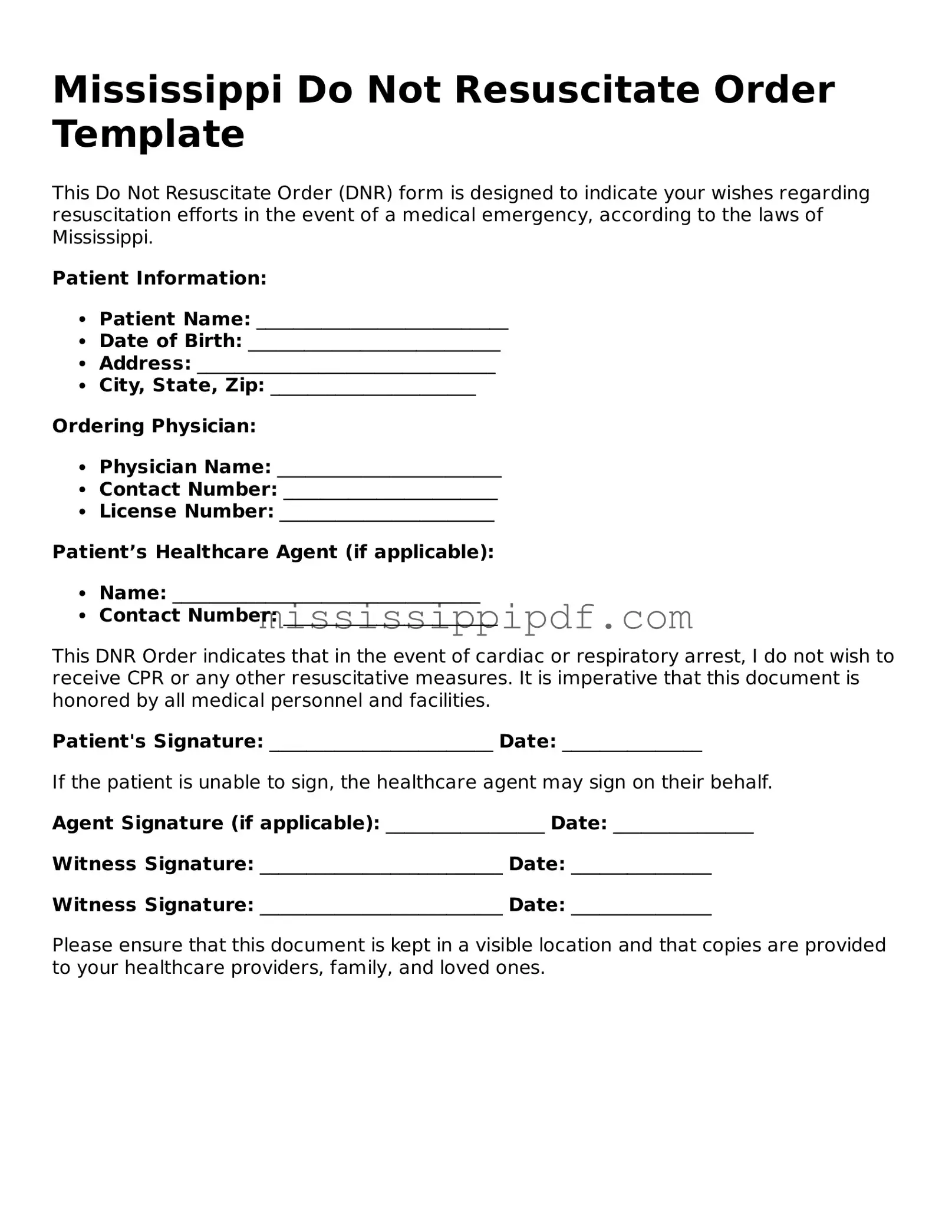The Mississippi Do Not Resuscitate (DNR) Order form shares similarities with the Advance Directive, a legal document that outlines a person's preferences regarding medical treatment in situations where they cannot communicate their wishes. Both documents allow individuals to express their desires concerning life-sustaining measures. While the DNR specifically addresses the refusal of resuscitation efforts, the Advance Directive can encompass a broader range of medical decisions, including the use of ventilators and feeding tubes. Each document serves to ensure that a person’s healthcare preferences are honored, even when they are unable to articulate them due to medical conditions.
Another document akin to the DNR is the Physician Orders for Life-Sustaining Treatment (POLST) form. The POLST is designed for patients with serious illnesses and provides specific medical orders regarding treatment preferences. Like the DNR, it is a physician-signed document that conveys the patient’s wishes to healthcare providers. However, the POLST goes beyond resuscitation preferences, detailing a comprehensive plan for other interventions such as hospitalization and antibiotics. Both documents aim to communicate a patient's wishes clearly to medical personnel, ensuring that care aligns with their values.
The Living Will is another important document that parallels the DNR Order. A Living Will outlines a person’s wishes regarding end-of-life care and is particularly relevant when a person is terminally ill or in a persistent vegetative state. Similar to the DNR, it serves as a guide for healthcare providers and family members, detailing the types of medical interventions a person does or does not want. While a DNR focuses specifically on resuscitation, a Living Will can include broader directives about life-sustaining treatments, making both documents essential for comprehensive end-of-life planning.
Healthcare Power of Attorney (POA) is also comparable to the DNR form. A Healthcare POA designates an individual to make medical decisions on behalf of another person when they are unable to do so. While the DNR provides specific instructions about resuscitation, the POA allows the appointed person to interpret and make decisions based on the patient's values and preferences. This relationship emphasizes the importance of having a trusted advocate who can ensure that the patient’s wishes are respected in various medical scenarios.
The NYC Payroll form, designed by the Department of Labor Bureau of Public Work, is a crucial tool for contractors, allowing them to meet payroll notification requirements effectively. It serves as an optional recording and submission method that captures essential employee data such as hours worked, pay rates, and deductions, thereby promoting transparency within labor practices. For those seeking more information or access to the form, resources can be found at nyforms.com/, which provides valuable templates and guidance for compliant payroll management.
The Comfort Care Order is another document that shares similarities with the DNR. This order focuses on ensuring that a patient receives palliative care rather than aggressive treatments. It emphasizes comfort and quality of life, aligning closely with the intent of a DNR, which prioritizes the avoidance of invasive resuscitation efforts. Both documents reflect a commitment to patient-centered care, allowing individuals to choose a path that aligns with their values and desires regarding their health care.
The Medical Order for Scope of Treatment (MOST) form is also relevant in this context. Similar to the DNR, the MOST form provides a clear set of medical orders that reflect a patient’s treatment preferences, especially for those with serious or chronic conditions. It is designed to be used in conjunction with the DNR, offering more detailed guidance on the level of medical intervention desired. Both documents serve to communicate critical healthcare decisions to providers, ensuring that patients receive care that aligns with their wishes.
Finally, the Do Not Intubate (DNI) order is closely related to the DNR form. A DNI specifically addresses the patient’s wishes regarding the use of intubation in the event of respiratory failure. While the DNR prohibits resuscitation efforts, the DNI focuses on the refusal of mechanical ventilation. Both documents are crucial in guiding healthcare providers about the extent of interventions a patient wishes to receive, ensuring that their end-of-life care is consistent with their personal values and preferences.
